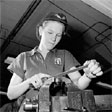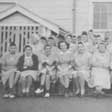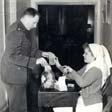War Industries
 |
Seven hundred fifty
thousand (750,000) Canadian women served in Canada's war industries. Prince Edward Island didn't receive any manufacturing
contracts that were handed out by the federal government, but Summerside and Island women are included in that 750,000 figure.
They packed their bags and headed to the war plants of the major Canadian cities. (Seven thousand Islanders worked in the factories
but breakdown of the sexes is not available.) Factories that had previously produced consumer goods now turned out weapons of war.
Women working in the aircraft industry could make thirty-one dollars ($31.00) per week, double their salary prior to the war.
They could go out and dance the night away with good-looking soldiers in training. It was an amazing sense of freedom and
independence. |
|
Civilian Workforce
 |
Four hundred thousand Canadian women (400,000) entered the civilian workforce. They took over the retail, banking, and office jobs
of men. These jobs were mostly in ones' own hometown. Towards the war's end, a trip to Holman's Department Store on Water
Street in Summerside would likely see the familiar face of the male clerk replaced by that of a local woman.
This too provided both the single and married women of the area an opportunity to contribute to the family finances and learn
the ways of the business world. |
|
Down on the Farm
 |
With men being called up daily to fight the war the number of farm workers was growing smaller. Farmers were considered essential
but often their sons could not receive an exemption from war service. This created a serious crisis as agriculture was
still labour intensive and the farms of Canada were feeding not only our own people, and the military troops, but also civilians
in England. Canadian women were again called upon to fill the shortage. Seven hundred sixty thousand (760,000) women tilled the
soil and harvested the crops. For many of them it was nothing new. They simply took over the roles of their husbands or brothers
along with their own chores, but for the women who came to the farms from the city it was hard work. |
|
The Volunteer
 |
Women knit socks by the thousands along with mittens, sweaters, balaclava helmets, and scarves for
the Red Cross to send overseas to troops and civilians. The Red Cross was very particular about the socks. If women
didn't knit them with a Kitchener toe they would be returned to them to fix. Canadian women also made clothing for
civilians of war-torn countries. They packed boxes of necessities and goodies for the soldiers and wrote letters by the
dozens to keep up morale. They held fundraisers to make money for war equipment and war supplies. They ran canteens for
servicemen and planned entertainment. In many ways these volunteer women were the backbone of home front communities. |
|







